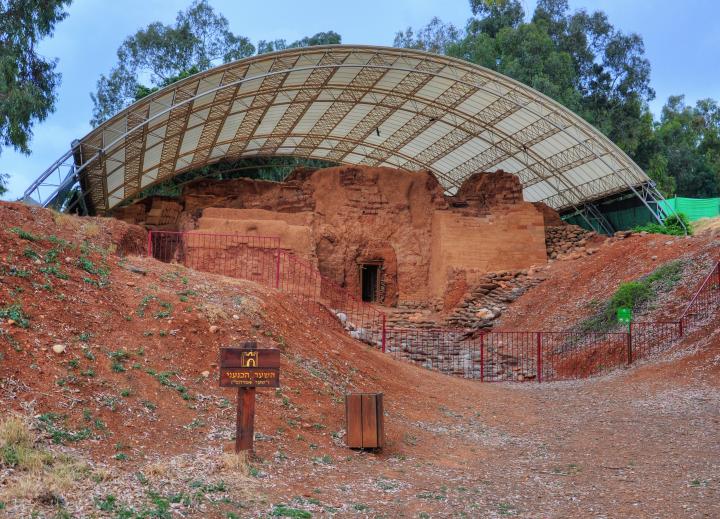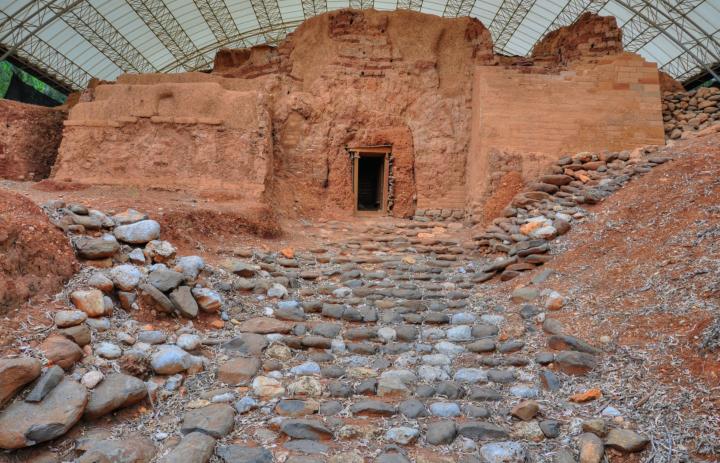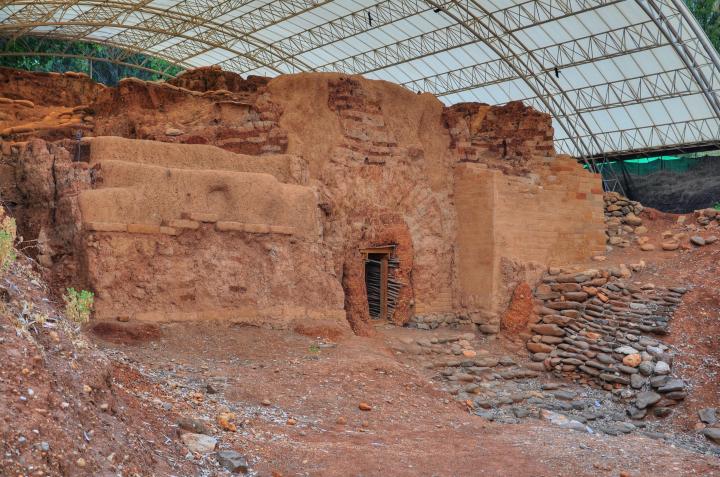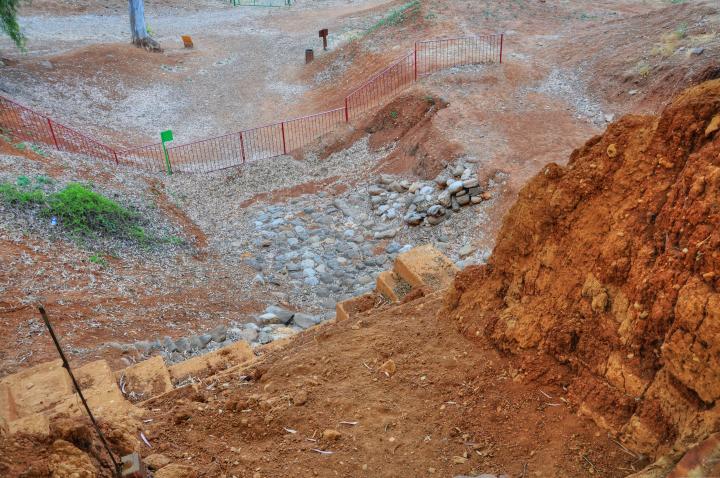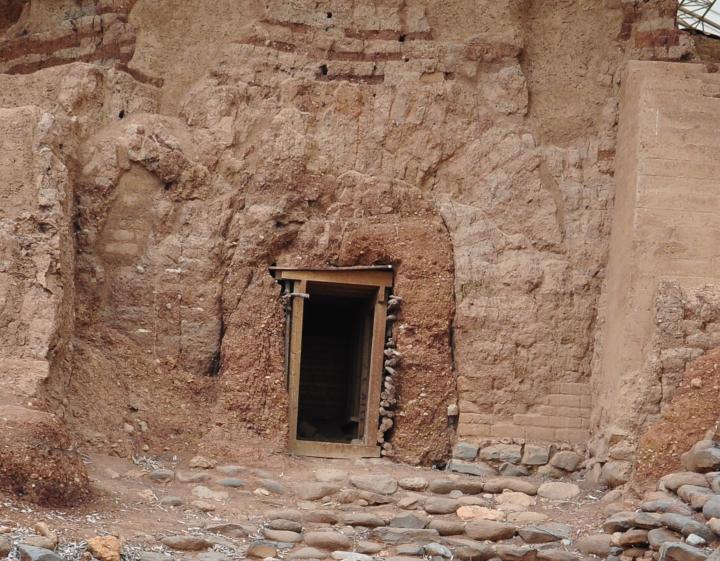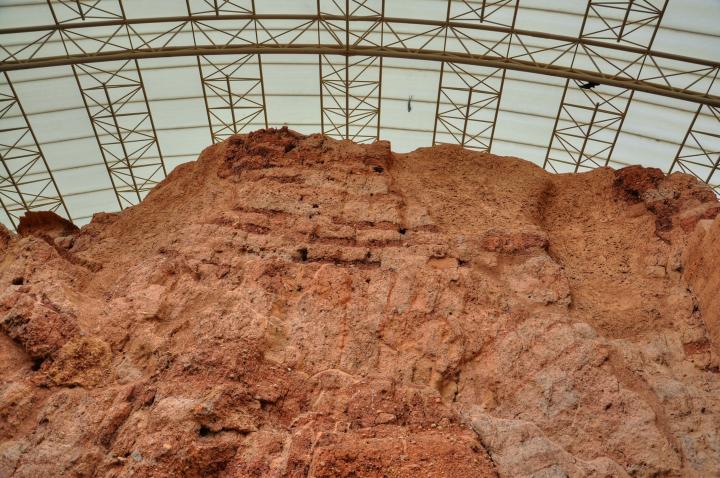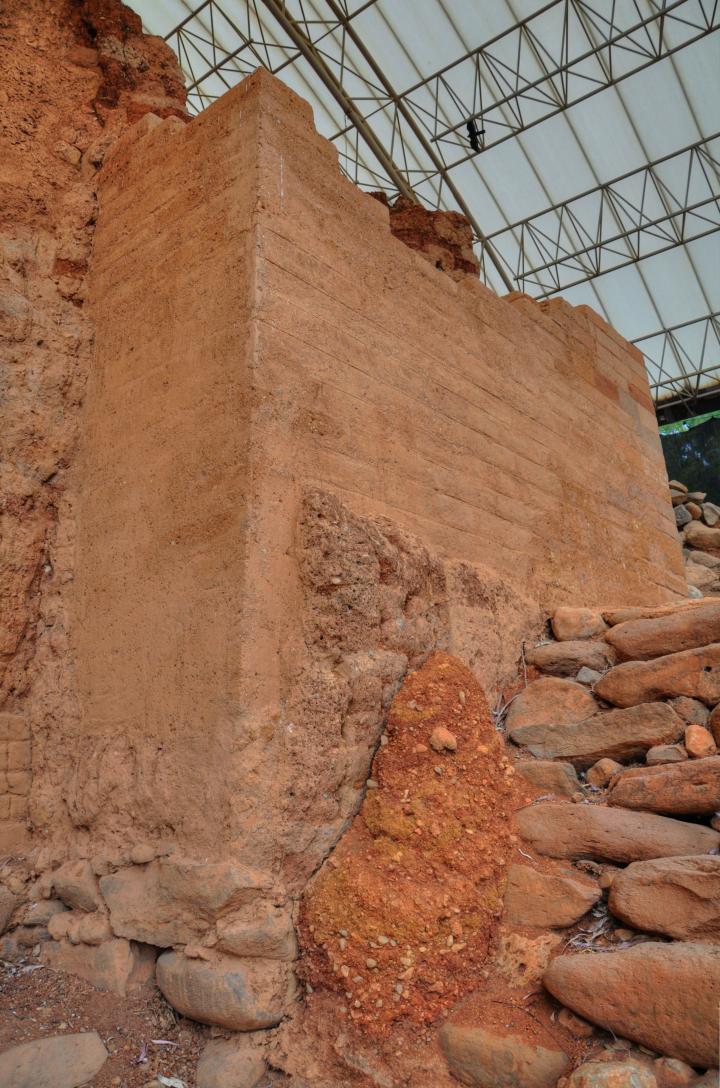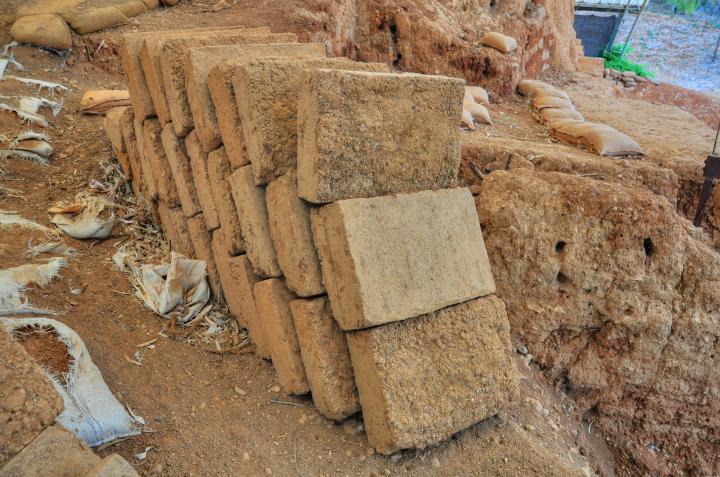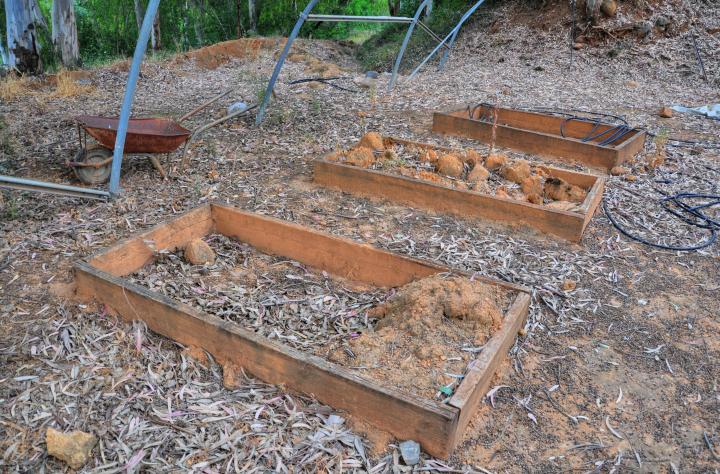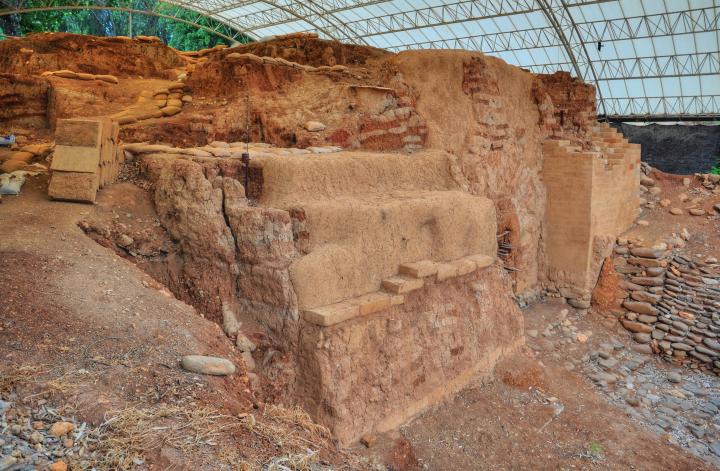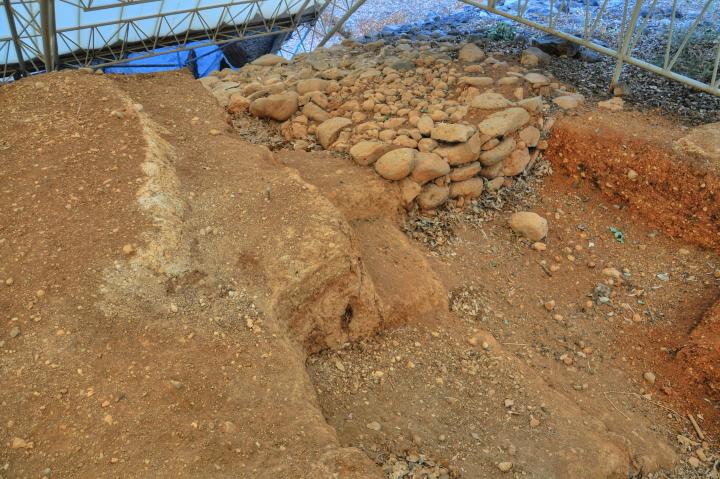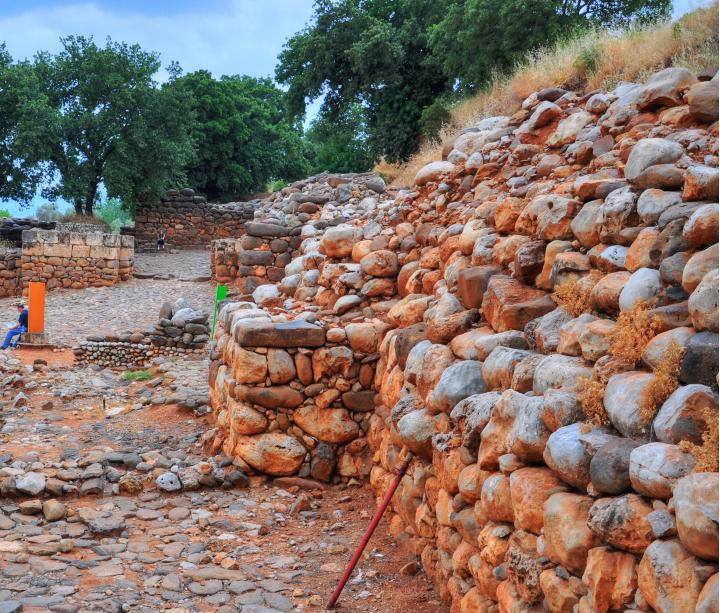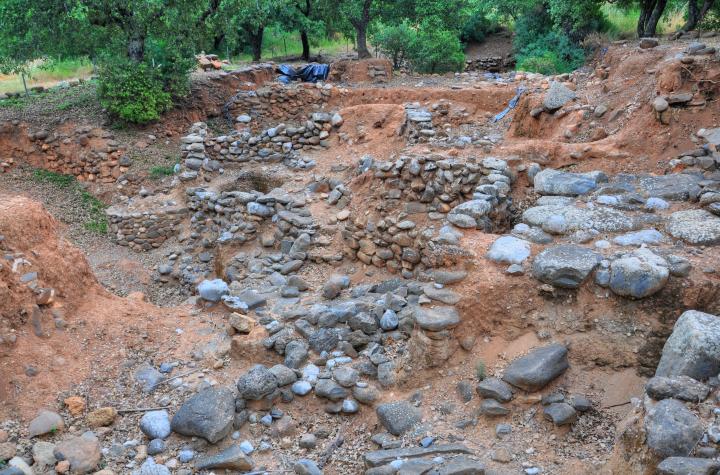This web page focuses on the Canaanite (Bronze age) city in Tell Dan – the Biblical city of Laish/Leshem.
Genesis 14:14: “And when Abram heard that his brother was taken captive, he armed his trained servants, born in his own house, three hundred and eighteen, and pursued them unto Dan“.
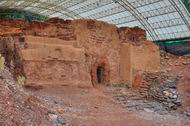
Home > Sites > Upper Galilee > East > Dan – Canaanite City
Contents:
Background
History
Photos
* General views
* Arches
* Bricks
* Walls
* Inside
Links
Background:
Tell Dan is an archaeological site in northern Israel that was the location of a Canaanite city dating back to the Bronze Age. The city was strategically located near the headwaters of the Jordan River and served as an important regional center for trade and commerce.
The Canaanite city at Tell Dan was known in ancient times as Laish, and it is mentioned in the Bible as a city that was conquered by the tribe of Dan (Judges 18). The city was later renamed Dan in honor of the tribe that conquered it.
Excavations at Tell Dan have revealed the remains of a large fortified city with impressive walls and gates, as well as a temple and other public buildings. The city also had a well-planned street grid and a sophisticated water system that included a large reservoir and a network of channels and tunnels.
One of the most famous finds at Tell Dan is a large stone stele, known as the Tel Dan Stele, that was discovered in the late 1990s. The stele, which dates to the 9th century BC, contains an inscription in Aramaic that refers to the “house of David,” providing important evidence for the existence of the biblical King David.
The Canaanite city at Tell Dan was an important cultural and economic center in the ancient Levant, and its remains provide valuable insights into the history and architecture of the region.
For a general description of Dan – see the overview page.
History:
The following focuses on the Canaanite period, focusing on the time period from the 18th century BC up to the 12 century BC. For a full history – check the overview page.
- Earlier Periods
Tell Dan was first settled starting from the end of the Neolithic Age (5th Millennium BC). In the Early Bronze age II (2700-2400 BC) the settlement increased to a size of a city. In the 20th and 19th C BC the city was under the rule of the Egyptian kings (12th Dynasty) . It is referenced in the late 19th C BC Egyptian enemy-curse clay tablets as “Hornab”.
- Canaanite period – Leshem/Laish
The Canaanite city was heavily fortified in the 18th century BC, and survived until the Iron (Israelite) Age in the 12th century BC.
The ancient city – named Leshem or Laish – covers a large area: the mount size is 200 Dunam (20 Hectares) and was one of the largest in the region. Its high walls were based on a huge raised earth glacis that surround the entire site. The style of these Glacis walls was Hiksos, an ancient Egyptian tribe based in the delta of the Nile, who dominated the region from 1720-1580 BC, and ruled Canaanite cities. The Hiksos design of glacis walls was used in several cities in Canaan, including Leshem/Laish.
This mighty city was located on the crossroads of major ancient trade routes and dominated the north side of Israel. Like the other great city in the north – Hazor – the city of Laish is mentioned in the 18th century BC texts in Mari (Euphrates river, Mesopotamia). The city is one of the cities that were conquered by Egyptian Pharaoh Thutmose III, just before the famous battle near Megiddo (1468 BC). This battle resulted in the defeat of the Canaanite coalition and started the Egyptian conquest of Canaan (which lasted for 350 years).
The city’s main gate was located on the east side. Its triple-arch entrance, made of sun-baked bricks, was reconstructed by the archaeologists. Since the gate was standing at the time of Abraham (about 15th century BC), who came here according to the Bible (Genesis 14:14), the gate is called “Abraham’s gate”.
- Early Israelite period – (12th – 10th century BC)
The Israelites conquered and possessed the Canaanite city in the 12th century BC. The Bible writes about this (Joshua 19:47): “…the children of Dan went up to fight against Leshem, and took it, and smote it with the edge of the sword, and possessed it, and dwelt therein, and called Leshem, Dan, after the name of Dan their father”.
Note that the Israelite period is covered in another web page.
Photos
(a) General Views
The 18th century BC Canaanite city had an impressive brick gate on its south-east side, 7m high, which was unearthed by the archaeologists. This is one of the unique findings in the Dan excavations, and a special protecting canopy covers it in order to prevent future damages to the ancient gate.
Click on the photos to view in higher resolution…
The photo below shows the front entrance to the city. A paved road leads up to the gate, which is located between two towers. The current opening of the gate is narrow, since it is supported by scaffolding fixture to prevent its collapse.
An illustration of the design of the triple-arch gate is shown here. The gate house is based on a series of 3 sequential arches which support the tower above the entryway. The entire height of the gate is 7m high.

It is remarkable that the gate was preserved for so long – 3,800 years. Sections of the original structure, with 47 courses of the brick layers, are preserved. This was due to the great design, a novelty at those times, and since it was eventually covered by the Israelites and buried under the new defense walls.
Another view of the 18th century BC Canaanite gate is below.
According to the Bible, this was the gate where Abraham passed during his pursuit against the North Kings (Genesis 14:14): “And when Abram heard that his brother was taken captive, he armed his trained servants, born in his own house, three hundred and eighteen, and pursued them unto Dan“.
A view from the top of the gate, looking down unto the entrance road:
(b) The arches
The external arch is better seen in the following photo. Above the scaffolding fixture is a filling, and above it is the bottom of the arch.
Behind the entrance are two more arches that supported the weight of the top of the gate.
A detail of the top side of the arch:
(c) Brick Reconstruction
The tower on the right side of the entrance is shown in detail below. Like all the elements of the gate, it is made by sun-baked bricks.
During the reconstruction of the gate, the archaeologists prepared similar bricks to fill in the missing segments.
These bricks were prepared using the ancient techniques of placing the mud into a mold, then baking it in the sun:
The new bricks were laid out in the gaps. A number of such bricks are seen along the front of the left wall. Future seasons will continue this work of preservation.
Sun-dried mud bricks have a long history of use in the Levant. These bricks, also known as adobe bricks, were commonly used in the construction of homes, buildings, and other structures due to their low cost and easy availability.
The process of making sun-dried mud bricks involves mixing mud with straw or other organic material, shaping the mixture into brick-sized molds, and then drying the bricks in the sun. This process has been used for thousands of years, with evidence of sun-dried mud bricks dating back to the Bronze Age in the Levant.
Despite their widespread use, sun-dried mud bricks have some drawbacks, such as their vulnerability to water damage and their susceptibility to erosion over time. However, they remain an important part of the architectural heritage of the Levant and continue to be used in some regions for their low cost and eco-friendliness.
(d) City Walls
The Canaanite’s city, known in the Bible as Laish (or Leshem), was a huge city (50 acres). It was heavily fortified by high glacis walls (reaching 10-15 meters), surrounding the whole city from all directions, and is the biggest Tell (ancient mound) in the north part of the Hula (Heleh) valley. These type of defense walls are typical of Biblical mounds, but here in Laish/Leshem they were immense. The style of these Glacis walls was Hiksos, an ancient Egyptian tribe based in the delta of the Nile, who dominated the region from 1720-1580 BC.
A section of the wall can be seen behind the gate.
The Canaanite glacis wall was composed of layers of of earth, stones, pebbles and other material, and was 60 to 70m thick! The center of the wall was composed of a thick (6m) wall of un-hewn stones, with compressed earth on both sides.
Most of the ancient Canaanite walls were incorporated into the Israelite city walls, including the gate. A section of the Canaanite walls may be seen on the right side of the Israelite wall in the following photo, which was taken near the Israelite Gate.
(e) Residential Area
Inside the city are traces of ruins, in which the archaeologists excavated residential houses of the city dated to the Bronze (Canaanite) period. Above them, on a higher layer, were remains of the later Iron (Israelite) period.
Links:
* External sites on Tel Dan –
- Tel Dan Nature reserve
- Tel Dan – Archaeology in Israel (2002)
- Dan – the Biblical city
- Tel Dan Excavations blog
* Internal sites:
- Tell Dan – Overview
- Tell Dan – Israelite city
- Dan – High Place
- Dan – Nature reserve
- Mud Bricks – Overview of sun-dried mud bricks used in ancient sites.
* Nearby sites:
BibleWalks.com – Travelling with a Bible in the hand
Dan Israelite City<<<–previous site—<<<All Sites>>>—next Upper Galilee site—>>> Dan High Place
This page was last updated on Mar 16, 2023 (mud bricks, new overview)
Sponsored links:
